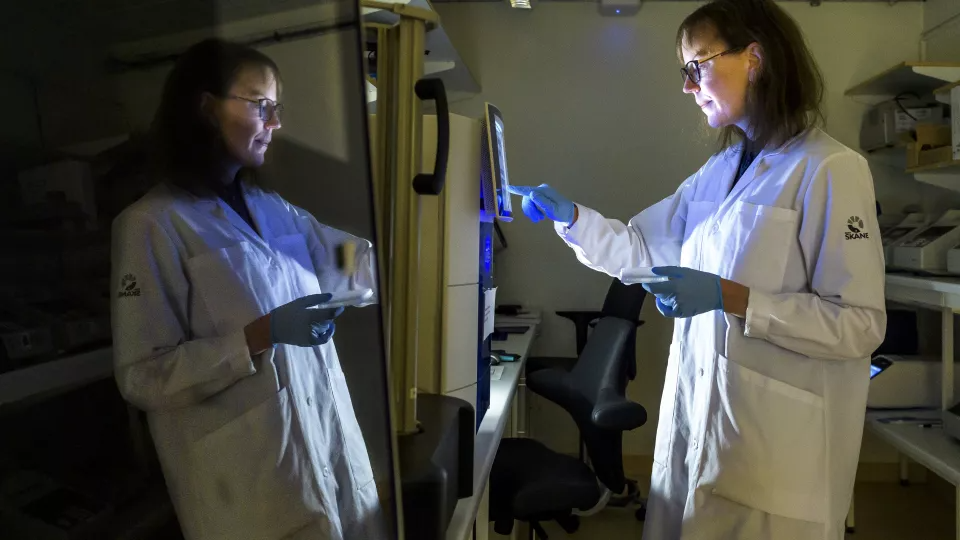Twin Study Finds Type 2 Diabetes Clues In Epigenetic Changes
Identical twins share the same DNA, but one twin can suffer from type 2 diabetes while the other twin does not develop the disease
 Researcher Emma Nilsson has analysed microRNA in fat biopsies from identical twins with and without type 2 diabetes. (Photo: Kennet Ruona) A study led by Lund University in Sweden has now discovered that there are differences in gene activity in twins where only one sibling had developed the disease. The researchers’ discovery could contribute to the development of new treatment methods.
Researcher Emma Nilsson has analysed microRNA in fat biopsies from identical twins with and without type 2 diabetes. (Photo: Kennet Ruona) A study led by Lund University in Sweden has now discovered that there are differences in gene activity in twins where only one sibling had developed the disease. The researchers’ discovery could contribute to the development of new treatment methods.
“Identical twins have the same genetic background, sex and age, and they are therefore interesting to study for researchers seeking to understand the mechanisms behind diseases. We found an epigenetic change in twins with type 2 diabetes which provides us with new clues to the disease”, says Emma Nilsson, researcher in epigenetics and diabetes at Lund University, and one of the principal authors behind the study.
For the study, 14 pairs of twins from Sweden and Denmark were recruited. Among the sibling pairs, one of the identical twins had developed type 2 diabetes. The average age of the participants was 68 years and the twins who had developed diabetes had a somewhat higher BMI compared to their sibling.
Epigenetic changes occur through DNA methylation, among other things, a chemical process that controls the function of the genes. The process is affected by various environmental factors, such as diet, exercise and stress. The researchers analysed DNA methylation and microRNA in fat biopsies from the pairs of twins to increase their knowledge about why only one twin had developed type 2 diabetes. MicroRNA regulates the production of proteins in the cells.
The researchers’ analyses showed that a gene responsible for producing a specific microRNA, microRNA-30, was less active in the twins with type 2 diabetes. This led to them having lower levels of microRNA-30 in their fatty tissue than their sibling. The same pattern was present in the control group, which consisted of 28 people with type 2 diabetes and 28 people without the disease. The participants in the control group were not biologically related to one another.
“We were able to confirm our results in individuals with no twin siblings and this proves that our results are relevant to all people and not only to identical twins”, says Emma Nilsson.
The researchers also conducted experiments in which they reduced the amount of microRNA-30 in cultured fat cells, to see how it affected the cells’ ability to take up glucose.
In type 2 diabetes, the body becomes worse at processing blood sugar. This is partly due to the cells having become less sensitive to insulin. Insulin resistance causes an increase in blood sugar levels. The researchers’ experiment showed that cells with a smaller amount of microRNA-30 also had a reduced ability to take up glucose.
“We see the same pattern in people with type 2 diabetes. The study is an importance piece of the puzzle in our work to understand the mechanisms behind type 2 diabetes. The more pieces of the puzzle we find, the better the new drugs we can develop”, says Emma Nilsson.
Increased knowledge about the mechanisms behind the disease could lead to more effective treatment of type 2 diabetes. Many patients experience side-effects, or find it difficult to achieve good control of their blood sugar with the drugs currently available. The researchers plan to follow up on their findings in forthcoming studies.
“Our study could be a step on the way to new treatment options in which microRNA is used as an active substance in drugs to treat patients with type 2 diabetes. Clinical studies are already underway in which microRNA is being tested as a drug against cancer, for example”, concludes Emma Nilsson.
The study, which is published in the journal Diabetes, was conducted in collaboration between researchers from Lund University, Sahlgrenska University Hospital in Sweden and Steno Diabetes Centre in Denmark.
Publication: Emma Nilsson, et al. Differential DNA Methylation and Expression of miRNAs in Adipose Tissue From Twin Pairs Discordant for Type 2 Diabetes. Diabetes, (2023). DOI: 10.2337/db20-0324
Original Story Source: Lund University

 Alerts Sign-up
Alerts Sign-up